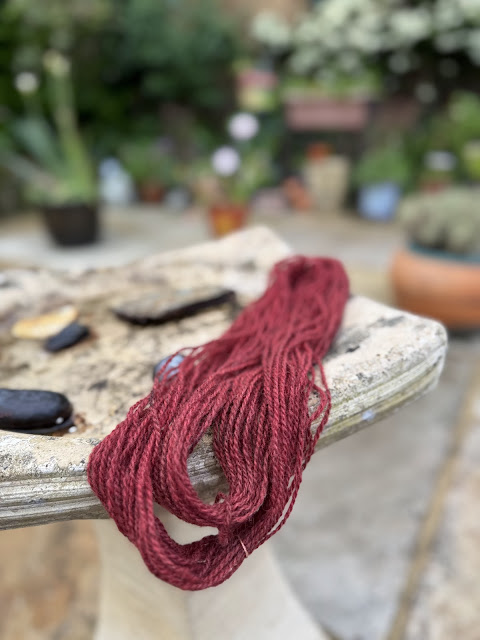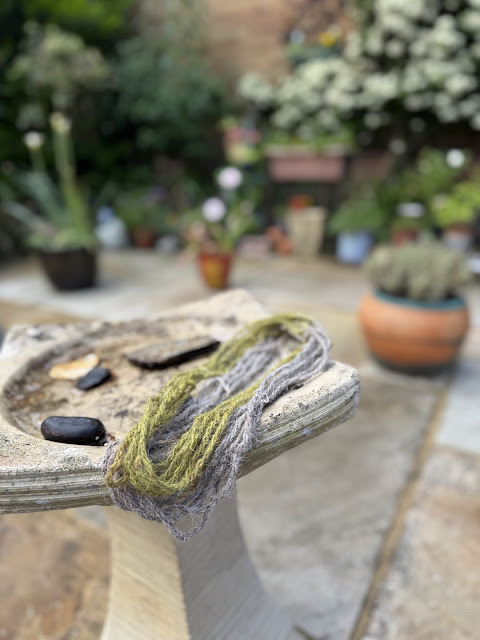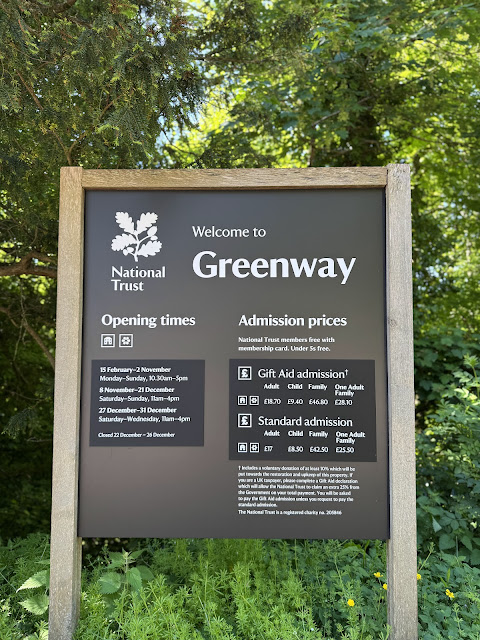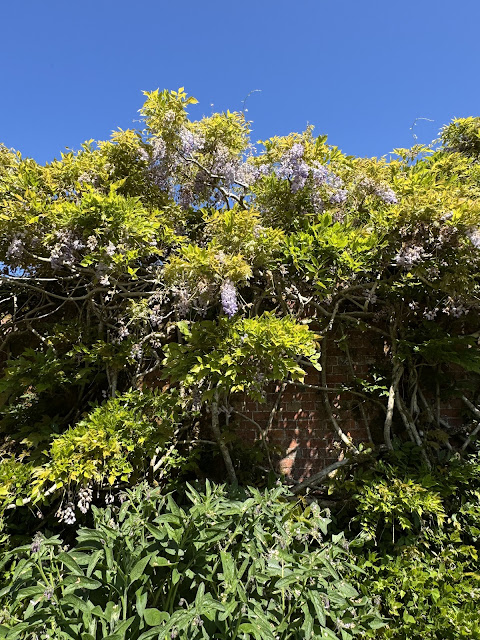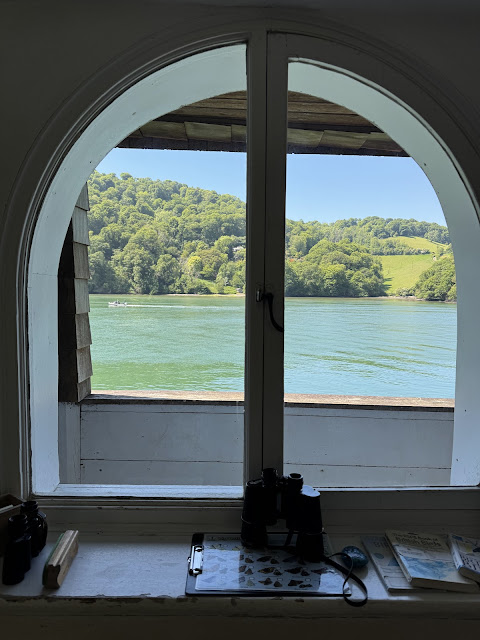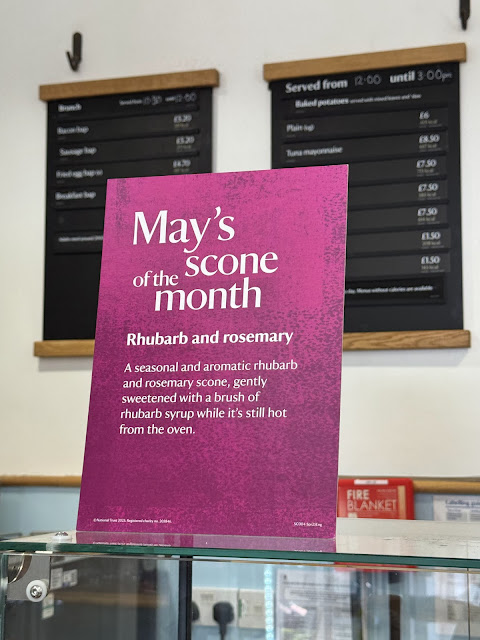Ria Burns has a huge wealth of knowledge having studied a textile masters at
Bath Spa. She has also just reloacted from Bristol to a more rural location that I know well in Congesbury. I know the area well as it is very close to where I grew up! She now has a studio and workshop space.
Ria brought along a lot of interesting information including her notebooks created while studying showing differnt yarn dye experiments.
At the beginning of the course Ria explained the different types of fibres that you can use to dye with.
Protein fibres include fibre from Sheep's wool, Llama and Alpaca's. You can also use Cellulose fibres such as Cotton, Hemp and Silk.
Plants that are used for dyeing fall into three categories.
Substantive dyes Walnuts, Pomegranate skins, Gall nuts, Turmeric, Indigo and Cochineal beetle.
These dyes DO NOT require the Mordant process to maintain the colour fastness.
Adjective dyes Madder, Weld, Coreopsis, Onion skins. Both Indigo and Cochineal are both substantive and adjective dye. Adjective dyes DO require the mordant process of the fibre to maintain the colour.
Fugitive dyes Red cabbage, Beetroot, Blackberries will fade in time. Fugitive dyes DO require the mordant process of the fibre to maintain the colour.
For dyeing the yarns they are best dyed in hanks with the yarn being tied in four places to hold it together whilst in the dye pot.
Depending on the dye being used you may first need to mordant the fibre which is a process that forms a chemical bond with the
natural fibre to hold the dye. The Alum mordant if used on it's own
would leave the fibre feeling course, so the cream of tartar makes it
feel softer.
For the workshop everyone received 8 mini skeins (approx 10g) each skein
of undyed yarn had been mordanted with Alum 9% and Cream of
Tartar 7%.
In order from bottom to top the yarns (I hope I have it correct) are:
- Somerset Lambswool 4ply Shetland Romney Grey
- Dorset Horn DK White
- Swaledale Aran Ecru
- Wensleydale DK Ecru
- Herdwick Chunky Grey
- Bluefaced Leicester DK White
- Bluefaced Leicester/Masham 4ply Grey
- Shetland Romney Lambswool 4ply White
For dyeing our yarn there were four dye options.
First is Madder or it's Latin name Rubia Tinctorum. A fascinating dye option where the root is used to produce a red dye. The history of this being used as a dye dates back over 5000 years and traces of it have been found in the linen of Tutankhamen’s tomb (1350 BC). To obtain a big enough root can take the plant up to five years of growth for it to be sufficently big enough for use.

The next is Avocado is again a natural dye that has been used for centuries by indigenous peoples across Central and South America, as well as the Caribbean.
Both the skin and the stone inside can be used. For the best preservation for use for dyeing is to clean off as much of the green flesh as possible and then freeze until required for dyeing. It is interesting as getting a lovely pink hue from Avacado's can be affected not just from the Avacado itself but also the water hard or softness. Also the darker the skin of the Avacado the deeper the pink dye. To be able to get a reasonable amount of dye you would need about eight Avocado's.
Third is dye option is the Red Dahlia and Orange Dahlia. If you growing your own plants you can leave the flowers to start going over and use the petals as they are starting to fade. To save have the remainds of the flowers on your finished yarn it is best to soak the flowers in water until you have got a good amount of colour and then strain through a muslin cloth leaving the lovely orange water for dyeing with.

The final dye option was
Weld Latin name Reseda Luteola. Often grown as a cottage garden plant with yellow flowers growing to a height of 1.5 metres. The whole of the plant above ground is used, but most of the colour comes from the leaves.
To dye the fibre, firstly heat the water gently to a maximum of 80 degrees then add the fibre. If the water is any warmer than 80 degrees fibre will felt.
To obtain a good amount of colour you need to dye the yarn for at least an hour but stirring every 15 minutes to ensure the colour is absorbed. After an hour you can turn off the heat and leave overnight to continue absorbing the dye.
During our dyeing we used Litmus paper to measure the pH levels of the water.
For a more
Alkaline pH add
Soda Crystals which can be purchased from a supermarket, to alter to pH. To make the pH more
Acidic add Lemon juice or vinegar.
These where all the finished hanks of yarn that everyone did.
Different methods where used in the dye pots, from tyeing knots in the yarn, or leaving part of the yarn out so that the dye worked it's way up the hank. But most were fully immersed.
These were my finished eight hanks of yarn which I felt it only right to photograph in my garden.
This yarn was dyed in the Avacado pink dye.
These two hanks were dyed in the Madder red dye. One of them being tied first while the other had the solid colour.
The Weld yellow dye I fully covered the first hank and the second was dipped in leaving some of the natural colour exposed.
The final
three hanks all went into the Dalia orange dye pot. I tied all of them to create the lovely
varigated colour of the hank from natural to dyed.
I am going to knit all the hanks up into a wall hanging which I shall proudly display in my craft room.
If
you ever get a chance to attend one of Ria's course I highly recommend
it, she is so informative and it was a great way to spend four glourious
hours.


























